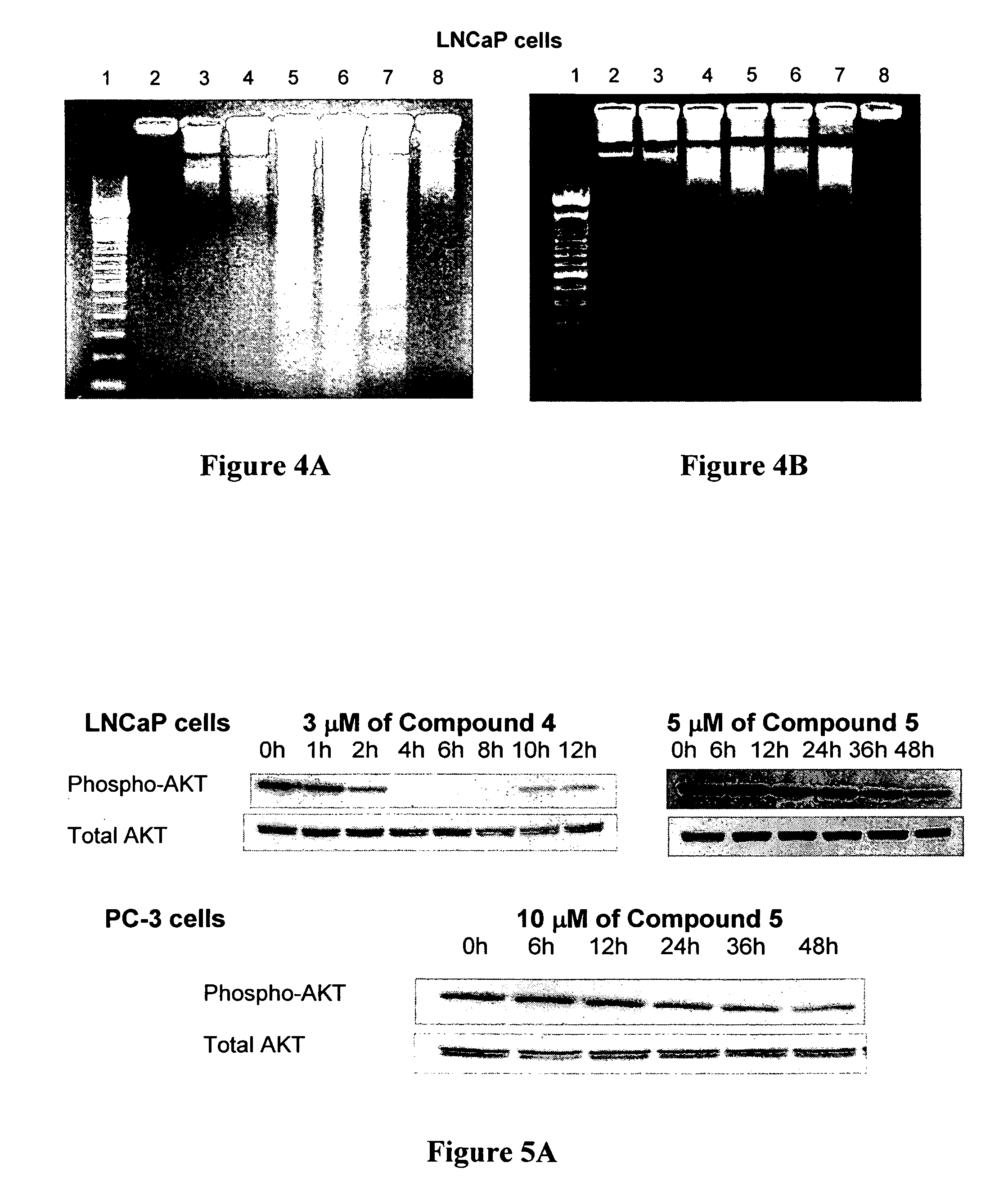Thiazolidinone amides, thiazolidine carboxylic acid amides, methods of making, and uses thereof
a technology of thiazolidinone and thiazolidine, which is applied in the field of novel thiazolidine carboxylic acid amides, can solve the problems of no clinically available therapies selectively exploiting or inhibiting lpa or pi3k signaling, and few options beyond, so as to improve selectivity and improve potency.
- Summary
- Abstract
- Description
- Claims
- Application Information
AI Technical Summary
Benefits of technology
Problems solved by technology
Method used
Image
Examples
example 1
Synthesis of Thiazolidine Carboxylic Acid Amides
[0090] All reagents and solvents used were reagent grade or were purified by standard methods before use. Moisture-sensitive reactions were carried under an argon atmosphere. Progress of the reactions was followed by thin-layer chromatography (TLC) analysis. Flash column chromatography was carried out using silica gel (200-425 mesh) supplied by Fisher. Melting points were measured in open capillary tubes on a Thomas-Hoover melting point apparatus and are uncorrected. All compounds were characterized by NMR and MS (ESI). 1H NMR spectra were recorded on a Varian 300 instrument. Chemical shifts are reported as 6 values relative to Me4Si as internal standard. Mass spectra were obtained in the electrospray (ES) mode using Esquire-LC (Bruker) spectrometer. Elemental analyses were performed by Atlantic Microlab Inc. (Norcross, Ga.).
[0091] All the compounds described in this study were prepared following straightforward chemistry. Reaction o...
example 2
Synthesis of N-Acyl and N-sulfonyl Derivatives Thiazolidine Carboxylic Acid Amides
[0118] N-Acyl and N-sulfonyl derivatives (compounds 28 and 29) were synthesized from compound 5 by standard procedures (scheme 2). Briefly, (2RS, 4R)-2-phenylthiazolidine-4-carboxylic acid octadecylamide (compound 5) was reacted with either acetic anhydride or methyl sulfonyl chloride, in pyridine, to afford the desired derivatives.
[0119] (2RS, 4R)-3-Acetyl-2-phenylthiazolidine-4-carboxylic acid octadecylamide (compound 28): 1H NMR (CDCl3) δ 7.31-7.41 (m, 5H), 6.01 (s, 1H), 5.12 (s, 1H), 3.73 (m, 1H), 3.40 (m, 1H), 3.31 (m, 1H), 3.11-3.17 (m, 1H), 2.00 (s, 3H), 1.27-1.33 (m, 32H), 0.89 (t, J=6.3 Hz, 3H); MS (ESI) m / z calcd for C30H50N2O2S 502.80 (M+), obsd 502.60.
[0120] (2RS, 4R)-3-Methanesulfonyl-2-phenylthiazolidine-4-carboxylic acid octadecylamide (compound 29): 1H NMR (CDCl3) δ 7.65-7.68 (m, 2H), 7.32-7.36 (m, 3H), 6.20 (s, 1H), 4.63 (dd, J=9, 6 Hz, 1H), 3.67 (dd, J=12, 6 Hz, 1H), 3.47 (dd, J=12...
example 3
Synthesis of Thiazole Carboxylic Acid Amides
[0122] The synthesis of thiazole derivative (compound 34) was accomplished starting from cysteine as shown in scheme 3.
[0123] To a solution of DL-cysteine (3 g, 24.76 mmol) in MeOH (50 mL) at 0° C., SOCl2 (2.76 mL, 37.14 mmol) was slowly added and warmed to room temperature then refluxed for 3 h. The reaction mixture was concentrated in vacuo to yield a residue. This residue was taken in to aqueous EtOH (1:1, 30 mL), NaHCO3 (2.28 g, 27.23 mmol) was added, after 10 min benzaldehyde (2.5 mL, 24.76 mmol) was added and stirring continued for 3 h. CHCl3 (200 mL) was added to the reaction mixture and washed with water, brine, dried (Na2SO4) and solvent was removed in vacuo. The crude product was purified by column chromatography to afford 2-phenylthiazolidine-4-carboxylic acid methyl ester (compound 31): yield 4.7 g, 85%; 1H NMR (CDCl3) δ 7.51-7.62 (m, 2H), 7.32-7.42 (m, 3H), 5.84 (s, 0.4H), 5.58 (s, 0.6H), 4.24 (t, J=6.3 Hz, 0.4H), 4.01 (t, J...
PUM
| Property | Measurement | Unit |
|---|---|---|
| Dimensionless property | aaaaa | aaaaa |
| Composition | aaaaa | aaaaa |
| Structure | aaaaa | aaaaa |
Abstract
Description
Claims
Application Information
 Login to View More
Login to View More - R&D
- Intellectual Property
- Life Sciences
- Materials
- Tech Scout
- Unparalleled Data Quality
- Higher Quality Content
- 60% Fewer Hallucinations
Browse by: Latest US Patents, China's latest patents, Technical Efficacy Thesaurus, Application Domain, Technology Topic, Popular Technical Reports.
© 2025 PatSnap. All rights reserved.Legal|Privacy policy|Modern Slavery Act Transparency Statement|Sitemap|About US| Contact US: help@patsnap.com



